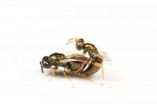(Press-News.org) Over a span of nearly 20 years, California's tobacco control program cost $2.4 billion and reduced health care costs by $134 billion, according to a new study by UC San Francisco.
Additionally, the study -- covering the beginning of the program in 1989 to 2008 -- found that the state program helped lead to some 6.8 billion fewer packs of cigarettes being sold that would have been worth $28.5 billion in sales to cigarette companies.
The study was designed to calculate the fiscal impact of California's large public health program on smoking prevalence and cigarette consumption. The new research shows that tobacco control funding is directly tied to reductions in both the prevalence of smoking and cigarette consumption per smoker – and generates significant savings in overall health care expenditures.
"These health care cost savings began to appear almost immediately after the program started and have grown over time, reaching more than $25 billion a year in 2008," said first author James Lightwood, PhD, a UCSF associate professor of clinical pharmacy.
The study will be published online Feb. 13, 2013 in the journal PLOS ONE.
Every year, an estimated 443,000 people in the United States die from smoking or exposure to secondhand smoke, according to the federal Centers for Disease Control and Prevention. Another 8.6 million people suffer from a serious smoking-related illness. Annually, costs associated with smoking-related illness account billions in medical expenses and lost productivity, and 5.1 million years of potential life lost in the United States, the CDC reports.
To help save lives and lower health care costs, California passed Proposition 99 in 1988 to create a tobacco control program. The voter-funded state program centers on changing social norms around smoking to reduce smoking and tobacco-induced diseases. The program combines an aggressive media campaign with community programs emphasizing three themes:
That the tobacco industry lies;
That nicotine is addictive;
That secondhand smoke kills.
The new UCSF research updates an earlier study by the same authors, adding five years of data and a more sophisticated economic analysis. The earlier paper covered 1989 through 2004.
The researchers found a significant association between cumulative per capita tobacco control funding and both smoking prevalence and cigarette consumption per smoker. Every cumulate per capita hundred dollars spent on the state's tobacco control wound up reducing smoking prevalence by 5 percent and reduced cigarette consumption per smoker by 139 packs a year, the authors reported.
Both a reduction in the percentage and number of people smoking, and the numbers of packs each remaining smoker consumed contributed to dropping health care costs, the authors found. The reduction in smoking prevalence accounted for 36 percent of the health care cost savings, with the rest due to less consumption among continuing smokers.
"Our research shows that large scale aggressive tobacco control programs not only save lives, but make an important contribution to health care cost containment," said senior author Stanton A. Glantz, PhD, a UCSF professor of medicine and director of the UCSF Center for Tobacco Control Research and Education.
The authors obtained these estimates by comparing smoking and health costs in California with 38 other states that did not have substantial state tobacco control programs or cigarette tax increases prior to 2000.
"The results show that the California tobacco control program had a substantial effect on both smoking prevalence and cigarette consumption per smoker, and both in turn had a substantial effect on per capita health care expenditures," the study concluded.
The estimated health care expenditures associated with smoking analyzed in the study included the short and long term direct effects on not only smokers but the effects of second- and third-hand smoke exposure to nonsmokers.
"Our research confirms that California voters made a good decision when they passed Proposition 99 in 1988," said Glantz. "The problem is that inflation is eroding the purchasing power of the California Tobacco Control Program at a time when cigarette companies are still aggressively promoting their products."
Tobacco companies narrowly defeated Proposition 29 last year, which would have increased the tobacco tax to reinvigorate the tobacco control program and to fund medical research.
INFORMATION:
The research was supported by TRDRP Grant 18ST-0201 and National Cancer Institute Grant CA-61021.
UCSF is a leading university dedicated to promoting health worldwide through advanced biomedical research, graduate-level education in the life sciences and health professions, and excellence in patient care.
Follow UCSF
UCSF.edu | Facebook.com/ucsf | Twitter.com/ucsf | YouTube.com/ucsf
California's Tobacco Control Program generates huge health care savings, UCSF study shows
2013-02-14
ELSE PRESS RELEASES FROM THIS DATE:
Cracking the semantic code
2013-02-14
We make choices about pretty much everything, all the time – "Should I go for a walk or grab a coffee?"; "Shall I look at who just came in or continue to watch TV?" – and to do so we need something common as a basis to make the choice.
Dr John Fennell and Dr Roland Baddeley of Bristol's School of Experimental Psychology followed a hunch that the common quantity, often referred to simply as reward, was a representation of what could be gained, together with how risky and uncertain it is. They proposed that these dimensions would be a unique feature of all objects and ...
Finding 'Mr. Right,' how insects sniff out the perfect mate
2013-02-14
TEMPE, Ariz. – You may want to ramp up your romance this year by sharing a candlelight dinner, a walk on the beach, or even the scent of a perfume, but will that help you find your perfect mate? For one wasp species, it only takes a whiff of his special love potion to know whether he's "Mr. Right."
Unlike humans, most insects rely on their sense of smell when looking for a mate. Scientists have found that sex pheromones play an important role in finding a suitable partner of the same species; yet, little is known about the evolution and genetic basis of these alluring ...
Scientists discover how animals taste, and avoid, high salt concentrations
2013-02-14
New York, NY (February 13, 2013) —For consumers of the typical Western diet—laden with levels of salt detrimental to long-term health—it may be hard to believe that there is such a thing as an innate aversion to very high concentrations of salt.
But Charles Zuker, PhD, and colleagues at Columbia University Medical Center have discovered how the tongue detects high concentrations of salt (think seawater levels, not potato chips), the first step in a salt-avoiding behavior common to most mammals.
The findings could serve as a springboard for the development of taste ...
A war without end -- with Earth's carbon cycle held in the balance
2013-02-14
CORVALLIS, Ore. – The greatest battle in Earth's history has been going on for hundreds of millions of years, isn't over yet, and until now no one knew it existed, scientists reported today in the journal Nature.
In one corner is SAR11, a bacterium that's the most abundant organism in the oceans, survives where most other cells would die and plays a major role in the planet's carbon cycle. It had been theorized that SAR11 was so small and widespread that it must be invulnerable to attack.
In the other corner, and so strange looking that scientists previously didn't ...
Penn geologists quantify, characterize sediment carried by Mississippi flood to Louisiana's wetlands
2013-02-14
PHILADELPHIA — The spring 2011 flood on the Mississippi was among the largest floods ever, the river swelling over its banks and wreaking destruction in the surrounding areas. But a University of Pennsylvania-led study also shows that the flood reaped environmental benefits — transporting and laying down new sediment in portions of the Delta — that may help maintain the area's wetlands.
The study, led by Ph.D. student Nicole Khan of the Department of Earth and Environmental Science, is the first to quantify the amount of sediment transported to wetlands by a flood on ...
Happily married couples consider themselves healthier, expert says
2013-02-14
COLUMBIA, Mo. – Research shows that married people have better mental and physical health than their unmarried peers and are less likely to develop chronic conditions than their widowed or divorced counterparts. A University of Missouri expert says that people who have happy marriages are more likely to rate their health as better as they age; aging adults whose physical health is declining could especially benefit from improving their marriages.
Christine Proulx, an assistant professor in the MU Department of Human Development and Family Studies, examined the long-term ...
Facial structure may predict endorsement of racial prejudice
2013-02-14
The structure of a man's face may indicate his tendency to express racially prejudiced beliefs, according to new research published in Psychological Science, a journal of the Association for Psychological Science.
Studies have shown that facial width-to-height ratio (fWHR) is associated with testosterone-related behaviors, which some researchers have linked with aggression. But psychological scientist Eric Hehman of Dartmouth College and colleagues at the University of Delaware speculated that these behaviors may have more to do with social dominance than outright aggression.
The ...
NASA scientists part of Arctic Sea ice study
2013-02-14
New research using combined records of ice measurements from NASA's Ice, Cloud and Land Elevation Satellite (ICESat), the European Space Agency's CryoSat-2 satellite, airborne surveys and ocean-based sensors shows Arctic sea ice volume declined 36 percent in the autumn and 9 percent in the winter over the last decade. The work builds on previous studies using submarine and NASA satellite data and confirms computer model estimates that showed ice volume decreases over the last decade, and builds a foundation for a multi-decadal record of sea ice volume changes.
In a report ...
Resignation of Pope Benedict XVI demands a close look at rules of modern papal election
2013-02-14
New Rochelle, NY, February 13, 2013—When Pope Benedict XVI ends his reign at the end of February he will be the first pope to do so before his death in nearly 600 years. He shocked the Catholic Church by announcing his resignation and set in place a centuries-old process to select his successor. The fascinating Conclaves system for electing a new pope, which has been in place since the late 1200s is described in "Creating the Rules of the Modern Papal Election," published in Election Law Journal, from Mary Ann Liebert, Inc., publishers. The article is available on the Election ...
Why there are bad learners: EEG activity predicts learning success
2013-02-14
The reason why some people are worse at learning than others has been revealed by a research team from Berlin, Bochum, and Leipzig, operating within the framework of the Germany-wide network "Bernstein Focus State Dependencies of Learning". They have discovered that the main problem is not that learning processes are inefficient per se, but that the brain insufficiently processes the information to be learned. The scientists trained the subjects' sense of touch to be more sensitive. In subjects who responded well to the training, the EEG revealed characteristic changes ...



